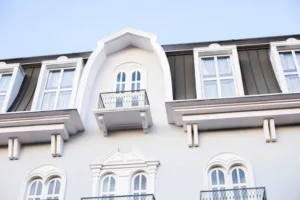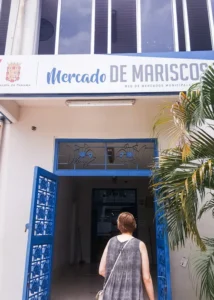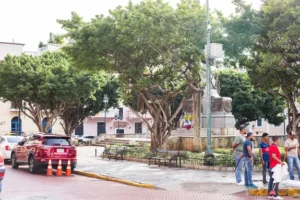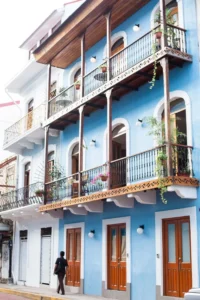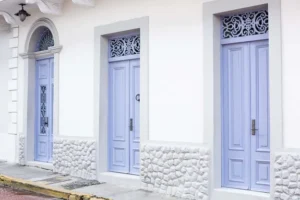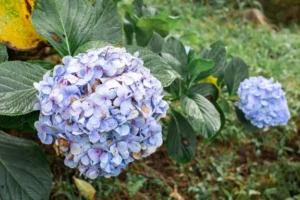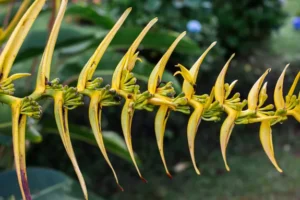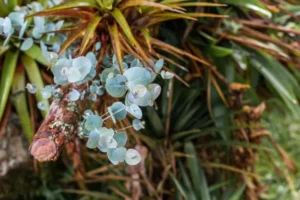Let's tell your story
Bright & glowy engagement session in st. marys, oh
Engagements
Lifestyle and wedding photographer passionate about capturing authentic moments with warmth and creativity.
Hi, I'm Sarah
I don’t know where to start except with, WE WENT TO PANAMA!
This year was a milestone birthday for my sister, so she planned a trip to Panama in Central America. This was my first trip out of the country. (Not counting Canada) So, of course, I was all about it! I was nervous but excited to experience new things and capture all the memories. I will do my best to explain everything you see below. I must apologize, though, because about 85% of the photos are buildings. I fell in LOVE with the architecture of Casco Viejo.
The name Panama is known as “abundance of fish, trees and butterflies.” And let me tell you, they had many, many beautiful tropical flowers and trees, fish, and butterflies. Brace yourselves, this is going to be a LONG one. Get ready to scroll.
We first arrived in Panama City, where our hotel shuttle drove us from the airport to Magnolia Inn. Magnolia Inn is located in Panama’s “historic district,” known as Casco Viejo or Casco Antiguo. It was built following the near-total destruction of the original city, Panama Viejo. Our room was one of the penthouse rooms where we had a beautiful view of the city.
The first night we got there we just explored the city and settled in.
This beautiful, renovated church is the Cathedral of Panama City. The town square is lined with historical buildings, and, in the center, is a gorgeous white pavilion. There were also street cats everywhere, so I had to document them too!
Want a shaved ice treat? Why not get it right off the block!
We couldn’t visit Panama City and NOT see the canal. So, we took a taxi one evening, knowing that we would be inside or covered from rain at the visitors’ center. There are two seasons in Panama. Wet and dry. We visited during the wet season, which means by 2 or 3 p.m. you could expect a high chance of rain nearly every day. We were surprisingly lucky with everything we had scheduled though! Almost everyone we talked to mentioned this season was not receiving as much rain as usual and that it was a bit concerning. Back to the canal. I’ve always known of the canal and thought it was cool, but seeing it in person was pretty mind blowing. Just the sheer amount of work and lives lost and enormous size is outstanding.
In the morning, we also stopped by the historic ruins of Panama Viejo. It was the first European settlement along the Pacific. It’s all hard to imagine. So much history and culture in one city is truly stunning.
After our visit to Panama Viejo, we walked along the Cinta Costera — a long waterfront boulevard that has street vendors, lots of locals doing their daily workout, and a gorgeous view of the coast lined with the city skyscrapers. They also hold carnivals and other activities throughout the year. From there we walked to the famous fish market where fresh fish comes straight from the docks. I was starving (I’m always hungry, lets face it) so the first food vendor won. Kelly got her ceviche (which I tried, and it was really, really good!) And I ordered the red snapper. We shared a plate of yucca fries, which were also very tasty! They are a potato-like root vegetable.
Kelly got to go to the rooftop bar and restaurant she wanted to visit: Tantalo, which also is part hotel. It was such a fun, relaxed atmosphere. Afterward, we stopped at Ay Mi Negra, an exotic dessert bar, which was by far my favorite treat we had. I’m so glad we went and, even though there was a 30-minute wait for our ice cream, it was SO worth it! Watching them work with the liquid mixture on a cold plate as it thickened and then roll it into lovely, delicious ice cream rolls was MAGICAL.
One day, we had a whale watching tour, so we set out early to the marina —where our ferry waited. I didn’t capture many photos from this but did get a few videos. We took the ferry to Contadora Island, where we met our tour guide. The way our tour booking worked out we were the only ones scheduled that day. So, it was just me and my sister. He took us looking for whales, which took about 2 hours to find. Once you see humpback whales in person it puts things in perspective. These magical creatures are amazing. They migrate from Antartica to mate then go back after. They are truly beautiful, playful creatures. We had to take a speed boat to travel between the island and ferry. I’m so thankful I do not get seasick 🙂
We decided to walk around town to see the views a bit more before we headed to Boquete, our second destination.
And off we went to Boquete! Boquete is a small town on the Caldera River in western Panama. The surrounding Chiriquí Highlands are home to coffee plantations and the Barú Volcano National Park. We took two tours — the lost waterfalls hike and coffee farm tour. Both were so worth it! The waterfall hike was the most challenging hike I have done so far. It was only 2.8 miles, but it was almost constant inclines and jungle terrain. I had the lovely challenge of keeping my glasses from fogging up the first half of the hike. #glassesproblems The sweat was well worth it, though. Each waterfall was stunning, and our tour guide, Ed, kept us laughing and lighthearted — even when we had to use a rope to help us climb up our path.
Ed told us these posts were for MORAL support and not to lean heavily on them because they’re not that sturdy. I loved the moral support all the way!
The Coffee tour was my favorite out of the two tours. I LOVED it. Not only because I love coffee but because there is just so much information that is left out of the process. We learned about free trade and the market as well. In college, I watched a documentary called “Black Gold” that showed the coffee market for what it was, which is very broken. That was the first eye-opener for me. This tour just solidified everything and brought it back to mind.
The tour began with a walk around the farm. Our tour guide was super helpful and talked about the process, from start to finish. I will try to break this down so there’s not too much to read, but I might get carried away! We were at Finca Dos Jefes, which means the farm of two bosses. Dee Harris and Rich Lipner purchased the abandoned coffee farm in 2003.
Cafés de la Luna is organically grown, naturally processed, and carefully roasted on the premises. I found it really interesting that they farm in accordance with phases of the moon. The beds you see below are bamboo drying beds. Coffee beans are actually the seed of a fruit (who knew!) The cherries go from green to red when they are ripe.
Our guide told us about the negative environmental impact of some coffee processes. Big companies that want to save time and money choose a washing process. For this process, fruit covering the seeds/beans is removed before they are dried. This requires the use of specific equipment and substantial quantities of water. The coffee seeds also contain many layers of acids and vitamins. Some companies would dump that water back into the Caldera River, and it created algae and killed fish over time. The dry bed process is much more sustainable, although very time consuming and labor intensive.
Our tour guide explained that, depending on the variety, it can take approximately 3 to 4 years for newly planted trees to bear fruit. They continue to plant to ensure future harvests.
Coffee cherries turn a bright red when they are ripe and ready to be harvested. There is typically one major harvest a year.
We learned that the leftover skins can be and are used for compost to fertilize the earth for future plants. They also can be used to make “cascara” tea from the skins of the coffee fruit.
Also … I was in dog heaven! These cuties were all over the farm, and one even loved eating avocados. I couldn’t get enough of them. The farm also had lime, orange, and avocado trees everywhere! We were encouraged to pick any off the trees to take home.
After our walk around the farm, we tasted the coffee. The tour guide told us about the issues with fair trade coffee.
Fair trade aims to improve the lives of farmers around the world. For a coffee farm to receive the official Fair Trade Certification, it must adhere to highly regulated standards and pay a certification fee. As a result, these coffee producers are able to sell their coffee beans at a higher price, and hardly any of that money goes back to the farmers and workers. Direct trade was initiated when coffee roasters and specialty shops decided to purchase coffee directly from the farmer, thereby eliminating the middlemen. By reducing the distance between point of origin and point of consumption, roasters have more control over the quality of their coffee.
Some other things I learned about coffee: Coffee plants create caffeine as a pesticide. It’s their natural defense against pests. The two main types of coffee plants are Arabica and Robusta. Robusta is grown at sea level and has higher caffeine levels but also is more bitter and typically of lesser quality. It’s often used as a filler and in lower standard coffees. Arabica is grown at higher elevations. “Mountain coffee” is much higher quality in taste and flavor.
The difference between “dark” “medium” and “light” coffee is roasting time, which affects the taste and — only slightly — the caffeine content.
I encourage you to check out this video from Finca Dos Jefe’s website!
We had such an amazing time in Panama with many memories captured. I hope you enjoyed this post, and I look forward to sharing more adventures with you!
Category:
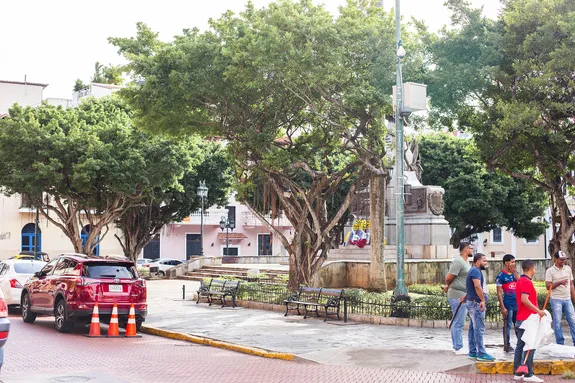
Panama
Leave a Reply Cancel reply
Brand & Website Design by Kylie Buss Design
© 2022–2024 Sarah Steinke Design
Terms
Privacy Policy
Sarah Steinke Design is a West Ohio-based photography studio dedicated to capturing authentic love stories with a timeless, artful approach. We ensure a seamless, comfortable experience from start to finish, creating heirloom-worthy images to cherish for generations.
